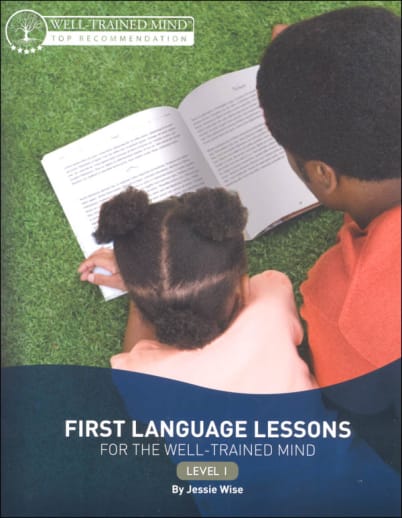A sampling of topics covered for first grade includes nouns (common, proper), days of the week, pronouns, capitalization, seasons, days, months, holidays, verbs, addresses, dates, and an introduction to sentence types. 188 pgs. paperback.
First Language Lessons for the Well-Trained Mind Level 1
Description
In First Language Lessons for the Well-Trained Mind, author Jessie Wise believes that children as young as first or second grade are capable of learning the correct use of language. After all, she says, if you believe in exposing your children to quality literature before they have begun to read proficiently (which most of us do), why shouldn’t we expose them to the sounds and sights of correct language and grammar usage? Although at this age learning these rules will require a lot more patience on both the part of the student and the teacher, learning it the right way early on is a huge step towards learning proper English and grammar rules later in life. Although it sounds like a big job, her books are very straightforward and easy to use.
The author’s goals for this series include: 1) training the student’s ears to be attuned to the sound of properly spoken language; 2) training their speech to the correct use of grammar; 3) having their attention sharpened by narrating parts of a story back to you after hearing it aloud; and 4) using correct language in writing.
Memorizing and reciting short definitions and rules to reinforce the sounds of correctly spoken sentences are the essence of this course. Memory work also includes poetry and prose pieces. Copywork starts with short sentences and progresses to dictation. Narration exercises, which include picture studies as well as stories, require responses in complete sentences. Grammar is taught by reciting definitions/rules in rhymes and rhythm chants and by diagramming. Everything is broken into manageable morsels that are easier for young children to digest and remember. The keys are repetition and practice. The four strands of this program continue through the levels with increasing complexity. First Language Lessons is designed to accompany separate phonics, spelling, writing, and penmanship lessons.
Teacher Manuals provide scripted lessons and all material used in the lessons. The optional Audio Companion CD (for Levels 1 & 2) provides theater-quality presentations of the fun poems, entertaining stories, memorable rhymes, and grammar songs found in the books. FLL Level 1 and FLL Level 2 cover first and second grade, one level per year; each contains 100 short lessons. Level 3 and higher of this program continue the basic components, but in addition to the teacher manual, a consumable workbook is provided for the student’s work. The consumable Workbooks for Levels 3 & 4 (3-hole punched; perforated) provide lesson examples, copies of memory work pieces, and space for student’s work. These courses can be completed in one year in about 30 minutes per day and 3 days per week.
| Product Format: | Softcover Book |
|---|---|
| Grades: | 1-1 |
| Brand: | Well-Trained Mind Press |
| Author: | Jessie Wise |
| ISBN: | 9781933339443 |
| Length in Inches: | 11 |
| Width in Inches: | 8.5 |
| Height in Inches: | 0.375 |
| Weight in Pounds: | 1.05 |

